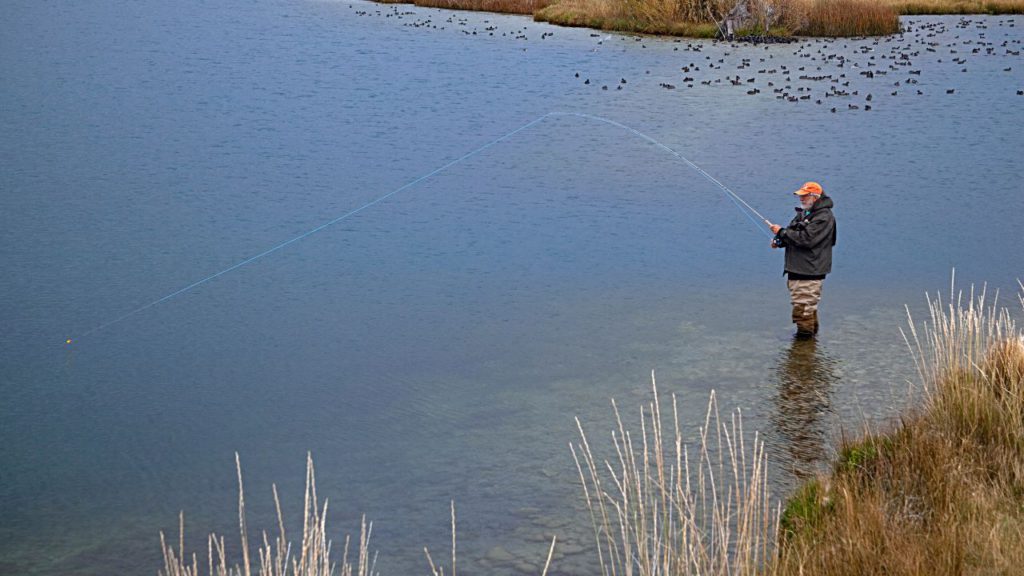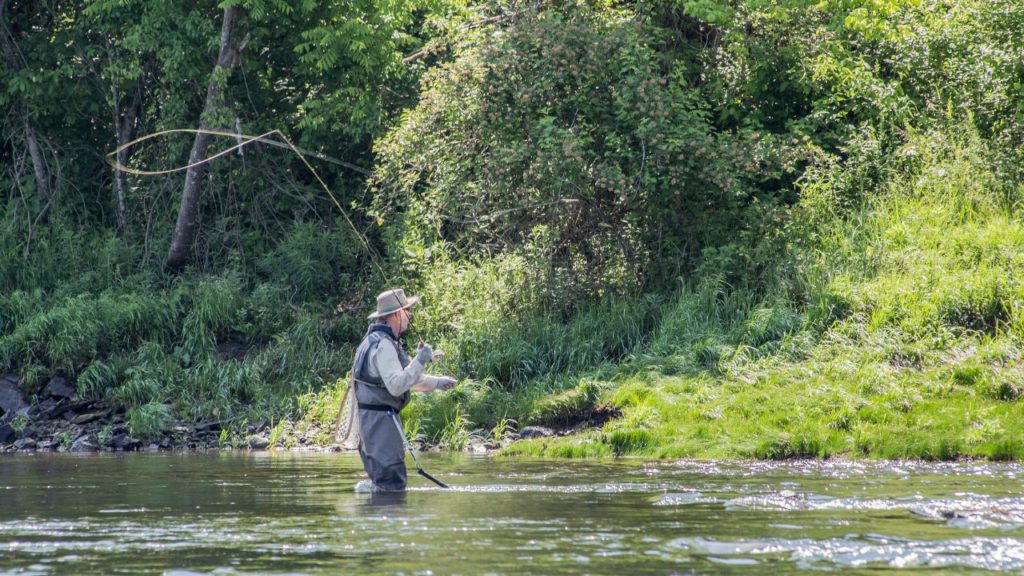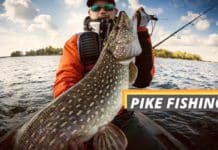Trout are among the most exciting fish to catch. Not only are they beautiful, but they are also naturally elusive and behave differently when in still and moving waters. For anglers, that means fishing for trout in lakes requires different tactics than catching trout in rivers and vice versa.
In this how to catch trout article, we’ll teach you the right way to fish for trout in lakes and rivers.
How to Catch Trout in a Lake

Trouts in still waters like a lake need to move and hunt for food. Typically, they thrive in temperatures below 70°-77° (depending on the trout species.) So, they tend to go deeper into the waters where the temperatures are cooler but not too deep that the water pressure exacerbates them.
They also hang around a particular area in the water called the thermocline. This borders the warmer top lake water and cooler bottom water. Trout love this area because it has the right blend of oxygenation and cooler temperatures.
Let’s look at everything there is to know about catching trout in a lake.
1. Have the Right Setup for Trout Fishing In Lakes
High-quality fishing gear is one of the main things you need for successful trout fishing in a lake. Here’s what you’ll need:
- Fishing Rod: For fly fishing, a 9-foot-long 5-weight or 6-weight fly fishing rod with medium-fast-action or fast-action. Alternatively, you can pick a 6-6.5-foot long medium to heavy spinning rod.
- Reel: If you have a 5-weight fly fishing rod, pick a reel that can hold a fly line weight range of 4-6. If you’re using a spinning fishing rod, choose a 20 or 2000-sized reel.
- Line and Leader: Opt for a 2-4lb test fluorocarbon or monofilament for spinning rods. Alternatively, use a 4/5/6 mono line and a 7X-0X (2 lb–10 lb) leader for trout fly fishing in lakes.
- Hook: A size 8 to 14 single hook is recommended when fishing for trout in a lake because they are less noticeable than other sizes and types of hooks.
- Sinkers: A sliding sinker is an excellent choice for trout fishing in lakes because it keeps your bait in your ideal trout fishing spot for longer.
2. Get the Right Bait
Another critical thing you need to know when learning to catch trout in lakes is the bait to use.
Usually, trout prefer light prey (although this depends on their size.) So, it’s advisable to stock up on small spoons or spinners. We also recommend using live bait that mimics their natural prey. Some live bait you can use include salmon eggs, night crawlers, and minnows. Even insects like crickets and grasshoppers are effective when trout fishing in lakes.
Expert Tip: If the trout in the lake you’re fishing on aren’t native, you don’t have to be too particular on the type of bait to use. This is because trout introduced into a lake often eat almost any prey.
3. Use the Correct Knot
The best type of knot for trout fishing is the improved clinch knot. For starters, this knot is easy to learn and suitable for small hooks. In fact, it’s the first type of knot most anglers know at the beginning of their fishing journey.
Here’s how to tie this fishing knot:
- First, pass the line through the lure or hook to have two parallel lines. Then, pull enough tag through, enabling you to wrap several times up the other side of the line and come back down through the loop right at the bottom.
- Wrap the line about 5-10 times, depending on how much slippage you think there will be and how strong you want your knot to be. Remember to keep your wraps uniform when tightening the knot.
- Next, pull the tag end through the loop above the hook eye when you wrap the line. Pull it down smoothly. Remember to wet the line before you do so.
- Focus on keeping the wraps uniform as the knot tightens around the eyelet. As you tighten the knot, it will come straight out of the eyelet.
4. Find a Trout Fishing Spot
Finding the perfect trout fishing spot involves understanding what they like regarding food, shelter, and water temperatures. Here are four ways to find the perfect trout fishing spot in a lake:
- Find an area in the lake likely to have abundant trout food like insects, worms, and other fish. As we explained earlier, trout have to move in search of food in still water bodies such as lakes.
- Use your fish finder to locate the lake’s thermocline area and track the ideal fishing depth.
- Look for rises. Rises are important when trout fishing because it indicates that they are actively feeding and that there’s probably a school of trout in that spot. This is a spot in the lake where you can see ripples as trout come to the water’s surface to feed.
- Look for places in the lake with shade and shelter. Trouts do not have eyelids, so they stay away from bright sunlight as much as possible.
Expert Tip: Trout are also prey. So, they naturally stay in areas where they can shelter themselves from their predators as much as possible.
5. Cast and Techniques
The last part of learning how to catch trout in a lake is mastering the appropriate casting technique.
If you are using a spinning rod, the best casting technique is the overhead cast:
- Grip the rod in your right hand.
- Then, you flip open the bail using your left hand and hook a section of the fishing line as it leaves the reel just before it reaches the first eyelet.
- Then, apply pressure on the line using the first joint of your index finger. Now flip the rod over your head and snap it forward at your target trout in the water.
If you are fly fishing, the roll cast technique is the best. To execute this technique:
- Lift your fly fishing rod high enough to raise most of your fishing line off the water.
- Then, push it forward with the snap of a wrist. This should make your line roll over itself, sending the rig flying forward into the water.
How to Catch Trout in a River

Since rivers are moving water, you’ll have to use a different approach. Trouts in rivers tend to stay in one spot and wait for the current to bring food to them. You just have to identify where they are most likely to congregate.
Here’s everything there is to know about how to catch trout in rivers.
1. Have the Right Fishing Setup for Trout Fishing In Rivers
Similar to fishing for trout in a lake, it’s also essential to have the right equipment to catch trout in a river successfully. Let’s take a look at what you need.
- Fishing Rod: If you are fly fishing for trout in a small river, a 7-8 foot-long fishing rod with medium to fast action is ideal. Alternatively, a 5-7 foot long spinning rod with an ultra-light to fast-action will also work.
- Reel: For a fly fishing rod, pair it with a 4/5/6 reel size (weight). We recommend going for a 20/2000-sized spinning reel with spinning fishing rods.
- Line and Leader: For trout fly fishing, use a 4/5/6 mono line and a 7X-0X (2 lb–10 lb) leader. On the other hand, use a 4 to 6-lb test fluorocarbon line for a spinning rod.
- Hook: Similar to trout fishing in lakes, you will need to use a size 8 to 14 single hook.
- Sinker: For 10-20m deep rivers, under 1oz sliding sinker is recommended. You can also use a bobber or a float when fishing in a large/wide river.
2. Get the Right Bait
When getting the bait for trout fishing in a river, it’s advisable to go for those that mimic their natural prey in the river. Some of the natural bait you can include earthworms, maggots, salmon eggs, corn kernels, and night crawlers.

Not comfortable with natural bait? You can use Powerbait pellets and other artificial trout lures like crankbaits and spoons.
3. Use the Correct Knot
There are many highly effective fishing knots for trout fishing in rivers. However, there are a couple that stands out. One of them is the improved clinch knot. It perfectly secures the lure to the line and retains about 95% of your fishing line’s original strength.
Another effective fishing knot is the snell knot. It is one of the strongest knots you can tie and is perfect for catching bigger trout.
4. Find a Trout Fishing Spot
The most important thing to know when learning how to catch trout in a river is where they are located. So, what areas are you likely to find trout in a river? The first area is the riffle. This is a rocky, shallow spot in a river where water cascades over the rocks, creating a visible surface.
Apart from this area having highly oxygenated water, most of the prey that trout eat, like insects, dwell there. Moreover, the rocks create a perfect place for trout to hide from predators.
Another area you’re likely to find trout in a river is the pool. This is the deepest section of the river with the slowest current. Bigger and inactive trout often tend to retreat to this area.
5. Cast and Techniques
There are many effective casting techniques for trout fishing in a river, but first, it’s important to know which direction to cast your bait in the river. Typically, fish, in general, face into a river’s current.
Therefore, it’s advisable to cast your bait upstream and bring it with the current flow. Doing so will mimic the natural presentation in the river, increasing your chances of catching a trout.
When it comes to casting techniques, the overhead cast is the best technique when fishing with a spinning rod. The roll cast technique is the most suitable one when fly fishing.
Catching Trout FAQ
What Are the Different Trout Fishing Methods?
There are several trout fishing methods. Among them include:
- Fly fishing: This method of fishing involves using an artificial fly as a lure to catch trout.
- Bait fishing: It involves using natural bait, mainly those that mimic trout’s natural food.
- Trolling: With trolling, anglers drag hooks with bait through the water.
- Float fishing: This fishing technique involves throwing bait mid-water underneath a float. If the float goes underneath the water, it signifies a trout has taken the bait.
- Fishing with jigs: Also known as jigging, this is a fishing method where anglers use a lure to mimic the movements of an injured trout’s prey. It is ideal for catching bigger trout.
When Is the Best Time to Catch Trout?
The best time of the day for trout fishing in a lake is early in the morning or later in the evening because they tend to be active during these times. When it comes to seasons, spring and fall are best because they don’t retreat deeper into the water.
On the other hand, the best time to catch trout in a river is early in the morning, preferably at dawn. You can also fish for trout late in the afternoon, preferably three hours before sunset through dusk.
Successful Trout Fishing Takes a Little Bit of Everything
As you have seen throughout the article, learning how to catch trout involves learning several things. This includes picking the right equipment, knowing the right spots to fish, mastering the proper casting techniques, and so on. Most importantly, successful trout fishing requires patience.
Table of Contents



